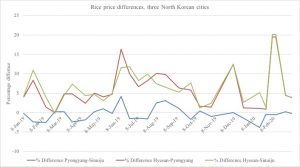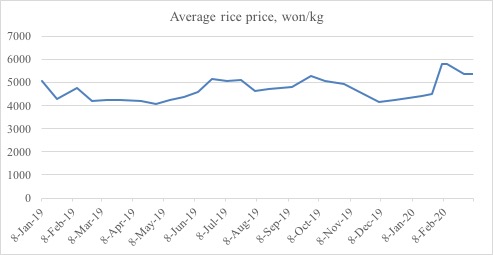Of price controls and panic: North Korean market prices under Corona
By: Benjamin Katzeff Silberstein
(Note: the graphs in this piece are from a shortly forthcoming article on 38 North.)
It’s almost like those mandatory disclaimers that often follow advertisements in the United States, but the statement that all information from inside North Korea is uncertain can sometimes not be repeated often enough. This is especially true in a situation like the current one, where the country’s borders are virtually shuttered, and global anxiety is high to begin with.
With that, let’s take a look at some numbers…
With North Korea’s border closing earlier this year, market prices quickly shot up as consumers most likely hoarded goods in anticipation of future shortages. Particularly curious was the fact that prices seemed to differ so widely between cities, as I wrote about here. This suggested that internal restrictions on movement between localities, a measure the state took to control the spread of coronavirus, were working. A few weeks later, however, both market prices and the differences between cities seemed to go down again.

So did market prices in general. In the latest price data observation from Daily NK, from March 7th, average rice prices are about 25 percent higher than a year ago, and 29 percent higher than in early December, before the border closure. That’ a lot, but somewhat less than the initial 36 percent increase when the border was closed initially. Even the slightly lower price increase would spell severe difficulties for many North Koreans in buying food. Note: the latest price observation is from March 7th, that is, several weeks ago.

So, what happened here? There are two possibilities that I think are more likely and realistic than others. One is that markets overreacted in their initial anxiety. Put simply, people may have thought that supply would become much lower than it ended up being. This is a common mechanism in markets in general. People often react more strongly than called for to anticipated, future changes, and then adapt their economic behavior once it’s clearer what actual conditions of supply and demand are. It’s also possible that the government let up on conditions for imports and trade, easing the burden on supply.
But there is another possibility. Both Rimjingang and Chosun Ilbo have reported that the government has instituted price controls to prevent prices from rising. This was only to be expected, as it is one of the few tools the state has at its disposal to control market anxiety. Price controls, however, are rarely (if ever) effective in the long run in countries such as North Korea. Either trade moves to the black market, or sellers run out of goods as they are forced to sell for less than consumers are willing to pay.
Aside from the two aforementioned reports, there are other potential signs that price controls may be in place. The price difference between Hyesan and Pyongyang/Sinuiju went down to a conspicuously low level, one that is actually lower than normal, a very odd coincidence. It got there only over the span of a few weeks, getting close to the 5,000 won-level reported by Chosun as the price ceiling. As far as currently available information can tell, no conditions changed on the ground. It would be reasonable to assume that at some point, the government may let up on restrictions on trade to ease conditions, but we don’t know whether that has happened yet. Reports of harsh measures against smuggling continue, and such measures would signal to the markets that state enforcement of the border closure remains and will remain harsh. So while in theory it makes sense that prices would go down somewhat after the initial spike, conditions on the ground have not changed noticeably, as far as we know.
So, what might have happened is that at least around March 7th, the government was still somewhat successful at enforcing its price ceiling, at least in parts of the country. One of Chosun’s sources reports that as of March 18th, rice cost 6,300 won per kg in Hyesan, much closer to the initial price level after the border closure. Price ceilings can usually only be enforced for a limited period of time, particularly when real shortages loom of essential products. Prices either rise beyond the ceiling, goods run out, or a black market arises. If the regime is indeed enforcing a price ceiling, and it continues to do so for a long time, perhaps we will see an increase in back-alley markets and other type of economic activity that the government has been relatively successful at curbing by integrating the markets into the official economic system over the past decade and a half or so.
View Original Article